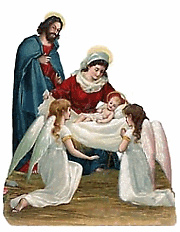When was the first Christmas card sent? Why do we kiss under the mistletoe? Learn the origins of Christmas and fun facts about some of our favorite christmas traditions and symbols.
There are lots of Christmas traditions that are practiced by a number of countries all over the world during the holiday season. These traditions can be as diverse as the culture and religious practices of each and every country in the world.
Origins of Christmas
 From the Old English 'Cristes M?sse' ~ meaning the 'mass of Christ' ~ the story of Christmas begins with the birth of a babe in Bethlehem.
From the Old English 'Cristes M?sse' ~ meaning the 'mass of Christ' ~ the story of Christmas begins with the birth of a babe in Bethlehem.
It is believed that Christ was born on the 25th, although the exact month is unknown. December was likely chosen so the Catholic Church could compete with rival pagan rituals held at that time of year and because of its closeness with the winter solstice in the Northern hemisphere, a traditional time of celebration among many ancient cultures.
Santa Claus
The origin of Santa Claus begins in the 4th century with Saint Nicholas, Bishop of Myra, an area in present day Turkey. By all accounts St. Nicholas was a generous man, particularly devoted to children. After his death around 340 A.D. he was buried in Myra, but in 1087 Italian sailors purportedly stole his remains and removed them to Bari, Italy, greatly increasing St. Nicholas' popularity throughout Europe.
His kindness and reputation for generosity gave rise to claims that he could perform miracles and devotion to him increased. St. Nicholas became the patron saint of Russia, where he was known by his red cape, flowing white beard, and bishop's mitre.

In Greece, he is the patron saint of sailors, in France he was the patron of lawyers, and in Belgium the patron of children and travellers. Thousands of churches across Europe were dedicated to him and some time around the 12th century an official church holiday was created in his honor. The Feast of St. Nicholas was celebrated December 6 and the day was marked by gift-giving and charity.
After the Reformation, European followers of St. Nicholas dwindled, but the legend was kept alive in Holland where the Dutch spelling of his name Sint Nikolaas was eventually transformed to Sinterklaas. Dutch children would leave their wooden shoes by the fireplace, and Sinterklaas would reward good children by placing treats in their shoes. Dutch colonists brought this tradition with them to America in the 17th century and here the Anglican name of Santa Claus emerged.
In 1822 Clement C. Moore composed the poem A Visit From Saint Nicholas, published as The Night Before Christmas as a gift for his children. In it, he portrays Santa Claus:
He had a broad face and a little round belly,
That shook when he laughed, like a bowl full of jelly,
He was chubby and plump, a right jolly old elf,
And I laughed when I saw him, in spite of myself;
A wink of his eye and a twist of his head
Soon gave me to know I had nothing to dread.
Other countries feature different gift-bearers for the Christmas or Advent season: La Befana in Italy ~ The Three Kings in Spain, Puerto Rico, and Mexico ~ Christkindl or the Christ Child in Switzerland and Austria ~ Father Christmas in England ~ and Pere No?l, Father Christmas or the Christ Child in France. Still, the figure of Santa Claus as a jolly, benevolent, plump man in a red suit described in Moore's poem remains with us today and is recognized by children and adults alike around the world.
(CRI December 23, 2008)